#winthrop kellogg
Text

"Ready for bed." Kingston Whig-Standard. June 21, 1933. Page 9.
----
For 12 months little Donald Kellogg has had Gua, an infant chimpanzee, as his constant companion, so that his father, Dr. W. N. Kellogg, professor of psychology at Indiana University, and his mother might record results of one of the most unusual scientific experiments ever attempted. As a result of tests concluded at their Kellogg Orange Park, Fla., bungalow, Dr. Kellogg declares that chimpanzees are far superior to the human child in memory, co-operative spirit and ability to grasp knowledge, but the chimpanzee, at the age of 16 months, has reached the peak of its ability to learn, while the child learns more with each day of instruction.
#university of indiana#winthrop kellogg#the ape and the child#chimpanzee#baby chimp#human experimentation#animal experimentation#comparative psychology#comparative developmental study#child development#the great depression#science experiments
1 note
·
View note
Text
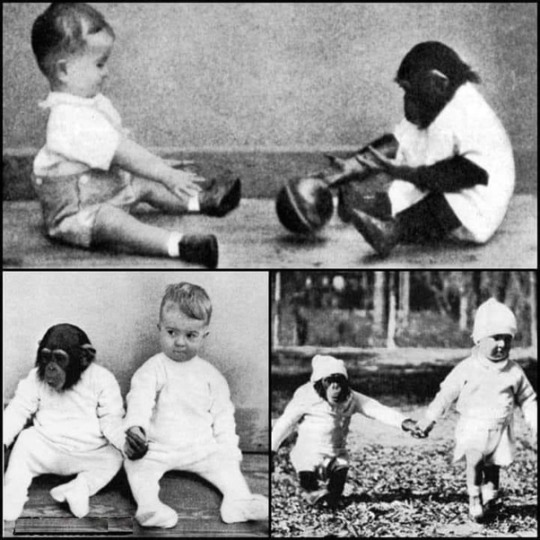
In 1931, two psychologists, Winthrop and Luella Kellogg, began an experiment to see if a chimpanzee could learn human behavior by raising it with their own baby. The idea was to see if the chimp, named Gua, would learn to walk upright, speak, and engage in other human-like activities.
For the first few months, the experiment was going well. Gua learned to mimic some of the actions of the Kellogg's son, Donald. After 9 months, the experiment was canceled. Some speculated that Donald experienced language issues from being around Gua, but the reason was never explicitly stated.
24 notes
·
View notes
Text
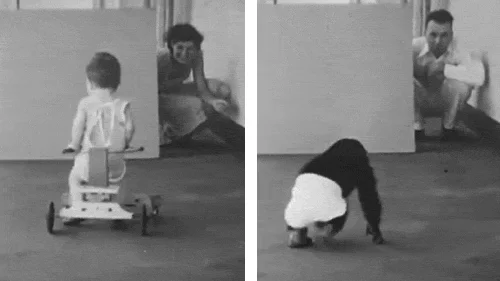
El experimento de Kellogg.
Dos psicólogos, Luella y Winthrop Kellogg, dieron a luz a un hijo al que llamaron Donald. Decidieron criar a su hijo con un chimpancé llamado Gua, en un experimento para determinar el efecto del medio ambiente en el desarrollo de los chimpancés y la posibilidad de humanizar al chimpancé.
Este experimento se inició cuando Gua tenía 7 meses y Donald 10 meses. Fueron criados como hermanos, comían a la misma hora, vestían la misma ropa, tenían los mismos juguetes y dormían en el mismo lugar.

A medida que avanzaba el experimento, Donald comenzó a imitar a Gua, haciendo los sonidos de un chimpancé y también caminaba como uno. Poco a poco se estaba convirtiendo en un niño salvaje. Esto provocó la terminación del experimento ya que esperaban que Gua imitara a Donald, no al revés.
El experimento tuvo un efecto duradero en Donald, quien se suicidó a la edad de 43 años. Mientras que Gua murió un año después de que se separara de Donald.
12 notes
·
View notes
Text
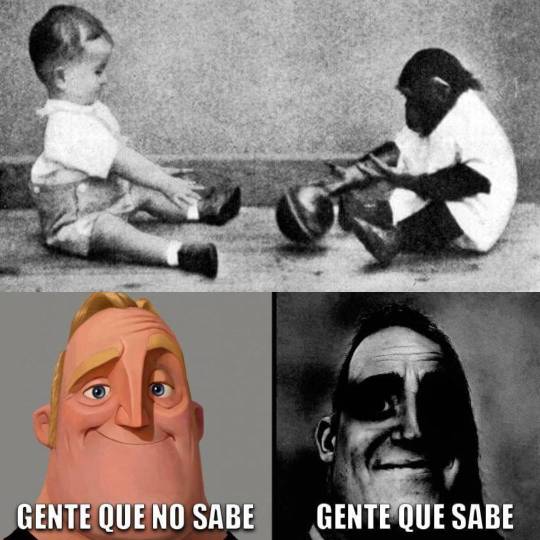
Un experimento de 1930 💀
Contexto aquí:
5 notes
·
View notes
Text
Extraordinary tale of scientist parents who adopted a chimpanzee to raise as their baby's SISTER...
Daily Mail News
By BETHAN SEXTON FOR DAILYMAIL.COM
PUBLISHED: 11:42 EST, 20 January 2024 | UPDATED: 11:45 EST, 20 January 2024
Extraordinary video footage shows how two scientist parents attempted to raise their infant son alongside a chimpanzee as part of a bizarre nature versus nurture experiment in 1931.
Psychologists Winthrop and Luella Kellogg conducted the study on their ten-month-old son…
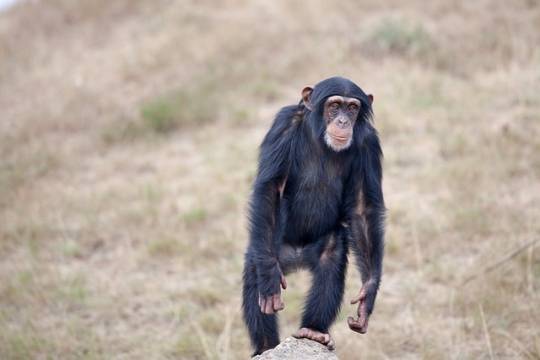
View On WordPress
0 notes
Text
The Extraordinary Experiment that Blurred the Line Between Human and Ape
In the 1930s, Winthrop Niles Kellogg and his wife Luella embarked on a peculiar journey of scientific curiosity and family dynamics. Their experiment involved raising a chimpanzee named Gua alongside their son, Donald, treating them as if they were brother and sister. The purpose of this unorthodox experiment was to observe the similarities and differences that would emerge between a human child…
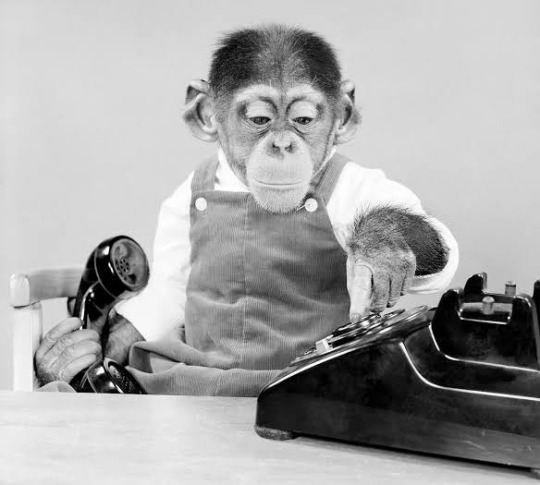
View On WordPress
0 notes
Text
ŞEMPANZE VE ÇOCUĞUN BİRLİKTE BÜYÜME DENEYİ…
ŞEMPANZE VE ÇOCUĞUN BİRLİKTE BÜYÜME DENEYİ…
Winthrop Niles Kellogg, 1898-1972 yılları arasında yaşamış bir karşılaştırmalı psikologdur. İsminden de anlaşılabileceği üzere, bu bilim dalı farklı hayvanların davranışlarını birbiriyle kıyaslayarak psikolojinin ve etolojinin (hayvan davranışlarının) temellerini anlamaya çalışır. Kellogg sıra dışı ve radikal bir karar alarak primatlar üzerine çalışmaya karar verdi.
Yapmak istediği deney de oldukça uç düzeydeydi: şempanze gibi bir kuyruksuz maymunu, bir insan bebeğiyle bir arada büyüterek davranışlarının karşılıklı olarak değişimini incelemek... Bu deneyiyle ilgili yapmak istediklerini, Humanizing The Ape (Kuyruksuz Maymunu İnsanlaştırmak) başlıklı makalesinde tüm bilim topluluğuna duyurdu. Kellogg, şempanze olarak Gua isimli bir bebek şempanzeyi seçti. İnsan yavrusu olaraksa, kendi oğlu Donald'ı denek olarak belirledi.
Kellogg'un bu hevesi, Hindistan'da kurtlarla büyütüldüğü için kurt gibi davranan insanlarla ilgili bir makaleden köken alıyordu. Kellogg'un iddiasına göre bu insanlar da, diğer sıradan insanlar kadar zeki doğmalıydı, yoksa vahşi hayatta varlıklarını sürdüremezlerdi. Dolayısıyla davranışlardaki "kurtlaşmanın" zeka geriliğiyle değil, çevre şartlarının o şekilde davranmaya zorlamasıyla ilgili olduğunu düşünüyordu. Kellogg, erken gelişimimiz sırasında başımızdan geçenlerin, ileri yaşlardaki davranışlarımızın temellerini attığını göstermek istiyordu. Ancak Kellogg, bir çocuğu düşük seviyeli bir ortama koyarak orada büyütmenin etik olmadığını ve yasal da olmayacağını biliyordu. Bu nedenle, tam tersini yapmaya karar verdi: bir şempanzeyi, insanların yaşadığı normal ortamda, onlar gibi yaşamaya zorlamayı denedi. Önceki deneylerde, hayvanın %100 insan gibi yaşaması hedeflenmiyordu, dahası, araştırmacılar bile buna kendini inandırmıyordu. Kellogg, bu bariyeri yıkarak yapılmamışı yapmak istedi.
Kellogg, yardımcı olarak ünlü psikolog, etolog ve primatolog Robert Yerkes ile çalışmaya karar verdi. Sonrasında 1931 yılında Yale Üniversitesi Sosyal Bilimler Araştırma Konseyi fonundan kaynak almayı başardı. Deney için, ailesini de alarak Florida'ya taşındı. Burada, doktora sonrası araştırmacısı Carlyle Jacobsen'ın üzerinde çalıştığı 1 yaşındaki dişi şempanze Gua ile tanıştı. 10 aylık oğlu Donald ile birlikte yaşayacak şekilde tüm planlar yapıldı.
Ve deney başladı...
Gua, tıpkı Donald gibi giydirildi, masaya oturtulup yemek yedirildi, yıkandı, eğitildi. Kellogg, olabildiğince sık bir şekilde iki yavrunun da gelişimsel niteliklerini test eden analizler yaptı. Tabii ki, beklendiği gibi, Gua Donald'dan daha hızlı büyüyordu; çünkü insanlarda gelişim çok daha yavaştır ve uzun bir süreye yayılmıştır. Bu nedenle Gua, bazı davranışları Donald'dan çok daha önce öğrendi. Aylar geçtikçe Gua, insanlara olan ihtiyacını yitiriyordu ve bağımsız hale geliyordu. Donald ise halen ebeveynlerine bağımlıydı.
Gua, hızla insan yeteneklerini de öğreniyordu. Sıradan bir insan gibi günlük yaşamda davranabiliyordu. Ancak yine de Kellogg'un beklentilerini bir türlü tatmin edemedi. Aslında Gua, bugünün araştırma standartlarında gerçekten çok büyük adımlar atıyordu, tıpkı bir insan gibi davranıyordu. Kellogg'u tatmin etmeyense, Gua'nın bir türlü insan dilini kullanmaya çalışmıyor oluşuydu. Bugün biliyoruz ki böyle bir şeyi beklemek bile akıl dışıdır, çünkü şempanzelerin hem ses kutusu, hem de beyinlerindeki konuşmayla ilgili bölgeleri insan dilini üretebilecek şekilde evrimleşmemiştir. Ancak Kellogg, çok büyük beklentilere sahipti.
9. aya girildiğinde, tuhaf bir durum görülmeye başladı: Gua insan dilini taklit etmeye çalışmıyordu; ancak Donald, şempanze dilini taklit etmeye başlamıştı. Örneğin yakınlarda yemek olduğunda, eğer ki Donald bu yemeği istiyorsa, tıpkı şempanzelerin yaptığı gibi "yiyecek çığlığı" atmaya başlamıştı. Bu durum, ister istemez Kellogg'u endişelendirdi. Zaten şempanzede insan dilinin taklidine yönelik herhangi bir değişim gözleyemediği için deneyi beklenenden 4 yıl kadar önce, 1932'de sonlandırma kararı aldı. Şöyle yazacaktı:
Gua, bir insan çocuğu gibi davranıldığı için, tıpkı bir insan çocuğu gibi davranmaya başladı. Tek sorun, vücudunun yapısı ve beyni buna bir noktadan sonra engel oluyordu.
Bunu gösterdiğimize göre, deneyi durdurabiliriz.
Konuyla ilgili sonuçlar Midwestern Psikoloji Derneği'nin yıllık toplantısında sunuldu. 1933 yılında The Ape and The Child (Kuyruksuz Maymun ve Çocuk) isimli bir kitap yazıldı. Kitap, deneyin tüm detaylarını kapsamlı bir şekilde anlatmaktadır.
Deneyin Videosunu izleyebilirsiniz:
https://www.youtube.com/watch?v=h-4Wl3sxtj4
ALINTIDIR…
1 note
·
View note
Text
Winthrop Kellogg: I will teach a monkey to be human.
gua:

donald:
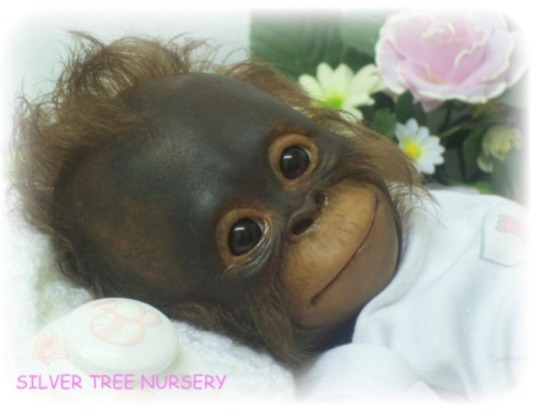
1 note
·
View note
Photo
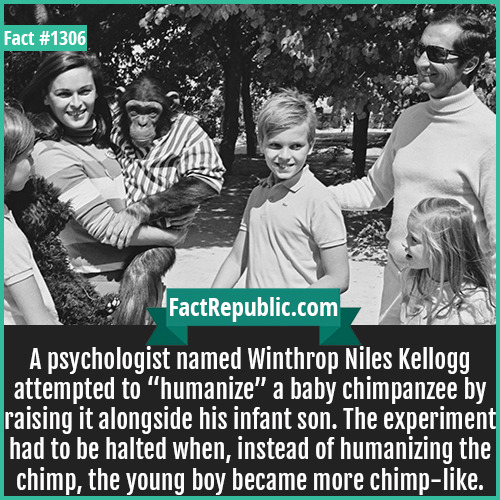
A psychologist named Winthrop Niles Kellogg attempted to “humanize” a baby chimpanzee by raising it alongside his infant son. The experiment had to be halted when, instead of humanizing the chimp, the young boy became more chimp-like.
#psychology#social#social experiment#social engineering#chimp#detective chimp#chimpanzee#experimental#experimentation#factrepublic#random facts#science facts#did you know#dyk
84 notes
·
View notes
Text
Bo Carter week 8, Sue Ryder week 7
Bo carter
Bo was ill this week so I just carried on with my drawings for her. This week I was drawing Gua the chimpanzee. Gua was born in November of 1930 in Cuba and was raised as though she was a human child by scientists Luella and Winthrop Kellogg alongside their infant son Donald. Gua was the first chimpanzee to be used in a cross-rearing study in the US.
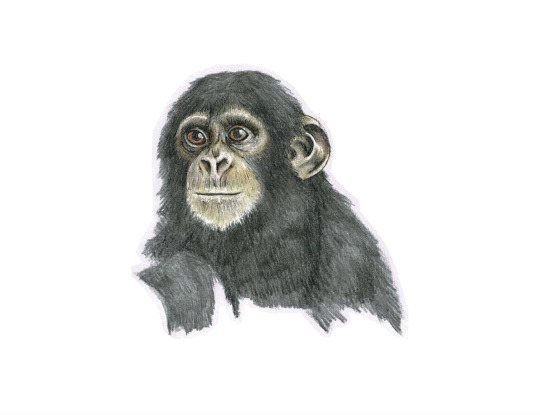

Sue Ryder
When creating my window display again this week, I alternated the coloured bistro sets in the window once again. I did this so I could keep varying the colours I had to work with, so this week I chose a lime green set and a blue set. After using different home décor to decorate these sets I moved on to the mannequins. For the female mannequin I had set aside a dress the week before that had both blue and green tones in a beautiful tropical print on white fabric. I paired this with a simple gold chain and a muted green bag. For the male mannequin I wanted to keep it quite simple and classic as to not overcrowd the window with too much pattern. So I chose a white button-down shirt with chinos and a smart belt.
Whilst searching for a belt for my mannequin I realised how many belts we had in the back, there was none out on the shop floor and nowhere for them to go. So I found a small shoe rack that had been donated and got to work. I found a small space on the wall where the dressing room once was. There were two hooks already in the wall. I gathered a range of men’s and women’s belts and started to display them on the rack, once I hung it up it didn’t look like a shoe rack anymore. It was also the perfect height to stop children pulling them down.
After doing this my manager gave me the task of moving the shelves around and putting out more summer accessories. I grabbed some hooks from the back room and some scarf rings and put out more summer hats and light-weight scarves in summer colours.

0 notes
Text
5 Eksperimen Ilmu Yang Ternyata Gagal
Setiap hari, para ilmuwan berusaha untuk membuat hidup kita lebih baik dan untuk lebih memahami kehidupan kita melalui serangkaian eksperimen pada hampir setiap subjek. Sayangnya, tidak semua proyek ini berjalan dengan baik. Kelima eksperimen ini semuanya salah, entah karena kesalahan para ilmuwan, perilaku subjek yang tidak diharapkan atau karena reaksi publik menghancurkan apa yang sebenarnya merupakan kemajuan yang menguntungkan di lapangan.
Gajah tersandung di parade
Sementara banyak hewan uji dibunuh atas nama penelitian, kebanyakan dari mereka setidaknya terbiasa menyelidiki obat-obatan yang berpotensi menyelamatkan nyawa. Mungkin kegagalan paling menyedihkan dan paling spektakuler dari percobaan berbasis binatang terjadi pada tahun 1962, ketika Tusko si gajah (bukan yang digambarkan) diberi LSD hanya untuk melihat bagaimana binatang yang luar biasa itu bereaksi terhadap zat semacam itu. Sayangnya, para periset, Louis Jolyon West dan Chester M. Pierce, tidak tahu berapa banyak LSD yang dibutuhkan untuk memberi dosis gajah. Alih-alih erroring di sisi keselamatan, para dokter memutuskan bahwa mereka tidak ingin melakukan eksperimen lagi hanya karena mereka menurunkan gajah tersebut pada saat pertama. Mereka akhirnya memutuskan untuk memberi Tusko 297 miligram, yang kira-kira 3000 kali dosisnya dikonsumsi manusia, terlepas dari fakta bahwa seekor gajah memiliki berat sekitar 90 kali lebih banyak daripada rata-rata manusia.
Setelah ditutup, Tusko segera mulai berlarian di pena dan segera kehilangan kendali gerakannya, akhirnya terjatuh ke tanah dan mengalami kejang. Untuk melawan LSD, dokter memberi gajah 2.800 miligram antipsikotik. Obat tersebut sedikit mengurangi kejangnya, tapi tidak menghentikannya. Setelah beberapa jam, para dokter memutuskan untuk memberi Tusko barbiturate untuk menenangkannya, tapi itu tidak membantu. Dia meninggal beberapa menit kemudian. Dua ekor gajah lainnya kemudian diberi obat dan tidak mendapat efek buruk. Pada akhirnya, dokter yang merawat Tusko menyimpulkan eksperimen mereka di Science dengan mengatakan, "Tampaknya gajah sangat sensitif terhadap efek LSD." Meski begitu, masih belum jelas apakah Tusko meninggal atau tidak karena asam atau Kombinasi dari tiga obat yang diberikan kepadanya hari itu.
Studi tentang Monster
Efek penguatan positif vs negatif telah membuat para ilmuwan dan orang tua terpesona selama ratusan tahun. Sayangnya, pengujian terhadap sekelompok anak yatim yang tidak curiga bukanlah cara terbaik untuk mengetahuinya. Pada tahun 1939, Doctor Wendell Johnson dari University of Iowa dan asistennya, Mary Tudor, memilih 22 anak dari sebuah panti asuhan di Iowa. Sepuluh anak memiliki gagap dan sisanya berbicara dengan baik. Orang gagap dimasukkan ke dalam dua kelompok, kelompok IA yang menggunakan penguatan positif dan kelompok lain, kelompok IB, yaitu menerima penguatan negatif. Orang-orang yang tidak tergagap juga terbagi dalam dua kelompok, kelompok IIB, yang diberi tahu bahwa mereka berbicara dengan baik, dan kelompok IIA, yang diberi tahu bahwa mereka mulai gagap dan perlu untuk menghindari kesalahan dengan biaya apapun. Tujuannya agar mereka yang berada di kelompok IA berhenti bicara dan orang-orang di kelompok IIA mulai tergagap.
Dampak pada kelompok IIA adalah persis seperti yang diharapkan dokter. Seluruh kelompok mulai tertinggal di sekolah mereka. Anak-anak mulai menebak kemampuan bicara mereka dan banyak yang berhenti berbicara sama sekali. Seorang gadis melarikan diri tak lama setelah percobaan berakhir. Sementara Mary Tudor mengunjungi panti asuhan itu tiga kali setelah percobaan usai, mencoba meyakinkan anak-anak bahwa mereka tidak memiliki masalah bicara, kerusakannya sudah terjadi. Meskipun tidak ada anak-anak yang menjadi orang gagap, banyak anak-anak mempertahankan masalah berbicara sepanjang hidup mereka dan sebagian besar enggan untuk berbicara. Pada tahun 2007, enam dari anak-anak ini mendapatkan $ 925.000 dalam sebuah tuntutan hukum terhadap negara untuk peran universitas dalam percobaan tersebut. Studi ini sejak itu telah dijuluki "The Monster Study" oleh publik dan ilmuwan yang sama-sama muak dengan metode dokter.
Bayi Lahir Seorang Simpanse
Ada banyak cerita tentang anak-anak manusia yang diangkat oleh spesies lain dan akhirnya menjadi lebih seperti hewan itu daripada manusia yang sebenarnya. Jika prosesnya bisa berjalan satu arah, Winthrop Kellogg yakin bahwa itu juga bisa terjadi pada yang lain, terutama jika hewan yang terlibat adalah salah satu sepupu genetik terdekat kami. Pada tahun 1931, Kellogg menerima hibah untuk eksperimennya dan waktunya tidak bisa lebih baik - istrinya baru saja melahirkan bayi laki-laki, David. Ini akan memberi mereka kesempatan unik untuk membesarkan seekor simpanse bayi, bernama Gua, tepat di samping bayi manusia. Tidak butuh waktu lama bagi bayi untuk terikat dan menjadi teman baik. Kellogg dan istrinya mengambil catatan sempurna tentang "anak-anak" kedua mereka yang mencatat perubahan fisik, emosi dan bagaimana mereka mencetak gol pada tes kecerdasan kecil. Simpanse tersebut mencetak lebih tinggi pada tes kecerdasan karena fakta bahwa spesies tersebut akan matang lebih cepat daripada bayi manusia.
Gua mengambil beberapa perilaku manusia, seperti berjalan tegak dan makan dengan sendok, tapi ia gagal belajar bagaimana berbicara dan belajar permainan pengulangan sederhana, seperti kue patty. Perasaannya juga jauh lebih mudah ditebak dan cenderung berubah setetes topi. Sayangnya, eksperimen itu benar-benar mulai salah saat David kecil mulai menjadi lebih seperti simpanse daripada Gua menjadi manusia biasa. Dia hanya mempelajari beberapa kata sederhana dan sering kali membuat lolongan simpanse saat dia menginginkan sesuatu. Setelah sembilan bulan, Kelloggs menyerah di Gua, khawatir bahwa David akan gagal tumbuh seperti anak manusia normal. Pada tahun-tahun sejak proyek ini, banyak orang telah mengadopsi simpanse sebagai bayi, membuktikan tanpa keraguan bahwa hewan tidak dapat bertindak sepenuhnya manusia-bahkan jika mereka menggemaskan di overall.
Demam Kuning
Dokter Stubbins Ffirth mengamati bahwa demam kuning menonjol selama musim panas, namun surut saat musim dingin mendekat dan membuat kesimpulan keliru bahwa ini berarti penyakit tersebut tidak menular. Fakta bahwa dia tidak pernah tertangkap penyakit ini setelah terus-menerus terpapar pasien dengan penyakit lebih lanjut menginspirasinya. Untuk membuktikan bahwa penyakit ini tidak menular, Ffirth memutuskan bahwa dia perlu mengekspos dirinya ke semua jenis cairan tubuh yang disekresikan oleh korban demam kuning. Dia meminum muntahan korban, dia menyuntikkannya ke pembuluh darahnya, dia menuangkannya ke matanya dan dia menghirup asap dari muntahan itu. Melalui semua itu, dia tidak pernah berhasil mengatasi penyakit ini. Alih-alih mengakui bahwa dia mengemukakan pendapatnya atau terus melakukan pengujian pada orang lain, Ffirth menyadari ada lebih banyak cairan tubuh baginya untuk bereksperimen. Dia menggunakan darah, air kencing, air liur dan keringat. Bahkan setelah semua tes ini, ia tetap berhasil menahan penyakitnya.
Sayangnya, Ffirth gagal memperhitungkan berbagai tahap penyakit. Sampelnya berasal dari orang-orang yang berada dalam tahap akhir penyakit tersebut, dan karena itu, tidak lagi menular. Seandainya dia bereksperimen dengan sampel dari orang-orang yang baru saja mengontrak penyakit ini, hasilnya kemungkinan akan jauh berbeda. Sedangkan untuk pengamatan penyakit itu hilang selama musim dingin? Dia benar tentang itu, salah tentang penyebabnya. Demam kuning disebabkan oleh virus RNA yang disebarkan oleh nyamuk. Itulah sebabnya mengapa hal itu jauh lebih umum terjadi pada musim panas yang lembab di Pantai Timur. Untungnya, sebelum penyebaran penelitian Ffirth, penduduk setempat percaya bahwa penyakit tersebut menyebar melalui jalur air dan Philadelphia mengenalkan sistem air tertutup yang membantu menghilangkan air mancur dan barel yang penuh dengan air yang berfungsi sebagai tempat berkembang biak nyamuk selama musim panas.
Bayi Tabung
Ini mungkin satu-satunya eksperimen sains dalam daftar ini yang benar-benar benar sampai gagasan diluncurkan ke publik. Dokter Fredric Skinner mengalami banyak kesulitan membungkuk ke tempat tidur bayi untuk menjemputnya. Saat istrinya hamil dengan anak kedua, ia bekerja keras untuk mengembangkan solusi yang lebih nyaman dan elegan. Apa yang dia temukan adalah "kotak bayi." Kotak itu tingginya sekitar enam kaki dan mengangkat bayi itu setinggi tiga kaki tingginya. Area tidur adalah tempat sampah dangkal dengan jendela kaca pengaman yang memungkinkannya melihat dunia luar sambil menyimpannya dengan aman. Kotak itu menyediakan bayi dengan pemanas, humidifier dan saringan udara sehingga bayi selalu memiliki udara segar dan hangat. Itu juga terisolasi dengan baik untuk mencegah suara keras. Orangtua bisa mengangkat bayi keluar dari perangkat tanpa ketegangan punggung. Si bayi tetap hangat, sehingga tidak perlu pakaian atau selimut yang bisa kusut dan menjadi bahaya. Plus, ini juga berarti lebih sedikit cucian untuk orang tua. Kasur itu terbuat dari selembar kanvas yang dipasang di tempat oleh dua rol, jadi saat menjadi kotor, mereka harus menggulungnya untuk mengungkapkan bagian bersih baru.
Semua dalam semua, perangkat itu memiliki banyak manfaat dan bayi dokter menanggapi perangkat dengan cukup baik. Sayangnya, Skinner memutuskan untuk memotong jurnal akademik dan mengirimkan pengumuman prestasinya melalui Ladies 'Home Journal. Sementara judul dari potongan yang dia kirim adalah "Perawatan Bayi Bisa Dimodifikasi," editor memutuskan untuk mengubahnya menjadi "Baby In A Box." Perubahan kecil yang satu ini sebagian besar bertanggung jawab atas reaksi publik terhadap gagasan revolusioner Skinner. Orang-orang menuduh dokter menangkis anaknya seperti binatang, membesarkan anak seperti kebun sayur dan mendapatkan inspirasi atas idenya dari sebuah kotak freezer. Sementara Skinner memang ingin menjalankan eksperimen formal yang membandingkan sepuluh anak yang dibesarkan dengan kotak itu dan sepuluh anak yang dibesarkan di tempat tidur untuk mengetahui apakah kedua kelompok tersebut memiliki kerugian dalam jangka panjang, kemarahan publik terhadap pekerjaannya menyebabkan dia mundur proyek. Putrinya sendiri tampaknya keluar dengan baik pada akhirnya, menjadi seniman sukses di London. Akhirnya, Skinner berhasil mendapatkan kesepakatan manufaktur, menjual beberapa ratus unit "The Air Crib", namun kepala perusahaan manufaktur tersebut segera meninggal dunia, membiarkan gagasan tersebut mati dalam prosesnya.
1 note
·
View note
Text
Artifact Series W
W.B. Yeats's Glasses
W.C. Field's Juggling Balls *
W. D. M. Bell's Mauser C96
W. G. Grottendieck's Stones
W. Heath Robinson’s Boiler
Wabi-Sabi Rock Garden Singing Sand
Waldemar Haffkine's Vaccine
Wallace Hartley's Violin
Wall Mounted Bottle Opener
Wally Schirra’s Insignia Patches
Walt Disney's Paintbrush *
Walt Whitman's Chalkboard and Chalk
Walter Chrysler's Building Spire
Walter Frederick Morrison's Cake Pan
Walter Freeman's Orbitoclast
Walter H. Thompson’s Telegram
Walter Halloran’s Crucifix
Walter Potter's Taxidermy Knife
Walter Potter's Taxidermy Wire
Walter Raleigh's Smoking Pipe *
Walter Schlage's Lockpick *
Walter Winchell's Tie Clip and Cufflinks *
Wang Mian’s Plum Tree
Wangari Maathai's Seeds
Wanksy's Spray Paint Cans
Warehouse 13.1 Diorama *
Washakie's Rattle
Washington Irving's Saddle
Washington Roebling's Caisson
Watergate Scandal Lock Picks
Watson Monitor
Wat Tyler's Lance
Wat Tyler’s Money Sack
Waverly Brown's Police Badge
Wax Crocodile
Way Bandy's Tie Clip
Wayne Gretzky's Hockey Puck
Wayne Wheeler's Hayfork
The Web of the Tsuchigumo
Webb C. Ball’s Railroad Chronometer
Wei Jingsheng’s Ballpoint Pen
Wendigo Mask
Wenham Wykeman-Musgrave's Plank
Werner Thomas' Accordion
Wes Craven's Freddy Krueger Glove
West Side Story Debut Playbill
The Western Jin's Hunping Jar
Where'd-It-Go Garden Gnome
"Where's the Beef?" Lady's Dress
Where's Waldo Misprint
Whip from St. Mary of Bethlehem Asylum
Whistler's Mother's Rocking Chair *
White Fan
The White Kiswah
"Whose Line is it Anyway's" Scenes from a Hat's American Hat
Wicked Bible
Wickham Family Dollhouse
Wild Bill Hickok's Playing Cards
Wiley Post’s Pressure Suit
Willem Jansz's Boomerang *
Wilhelm Kühne's Glasses
Wilhelm Reich's Cloudbuster *
Wilhelm Rontgen's Monocle
Wilhelm Voigt’s Army Uniform
Wilhelm Wundt’s Laboratory
Will Eisner's Unfinished Comic Book
Will Wright's Emerald
William Abner Eddy's Kite
William Allen White's Notepad
William Batty's Ringleader Bullhorn
William Beadle's Carving Knife
William Beaumont, 2nd Viscount Beaumont's Battle Armor *
William Beebe's Umbrella
William Bickford's Safety Fuse
William Blake's "Ugolino and Sons in Their Cell"
William Bleckwenn's Stethoscope (canon)
William Burke’s Quill
William Byke's Top Hat
William Chaloner's Groat
William Chaloner's Lottery Ticket
William Charles Pitcher's Costume Trunk
William Coffin Coleman's Arc Lantern
William the Conqueror's Scabbard
Sir William Cornwallis Harris' Epaulettes
William Dampier's Eyeglass
William Edward Parry's Inukshuk (canon)
William Etty's Canvas
William Frank Carver's Glass Ball
William Garrow’s Wig and Bands
William Gilbet's Lodestone Amber *
William Golding's Pen
William Hanna and Joseph Barbera's Pens
William Harvey’s Lens
William Henry Harrison's Podium
William Hornaday's Zookeeper Cap *
William Howard Taft's Bathtub Valve
William Irving's 'Bowling Pins'
William J. Simmons’ Klan Cloak
William James Sidis' Bookcase
William Jennings Bryan's Gold Certificate
William Kempe's Pipe and Tabor
William Kent's Twelve Guineas
William Kidd's Chest
William Kogut's Playing Cards
William L. Allen's Leather Helmet
William Makepeace Thackeray's Gravy Boat
William Masters' Stethoscope
William Mulholland's Clipboard
William Murdoch's Boiler
William Newton McComb's Infantry Sword
William Oughtred's Slide Ruler
William Penn's Hat
William Randolph Hearst’s Bulletin Board
William Redington Hewlett's Printer
William Robinson's Chest
William S. Graves' Lighter
William S. Sadler's Chaise Lounge
William Safire’s Apollo 11 Speech
William Schwenck Gilbert's & Arthur Seymour Sullivan's Top Hats
William Seabrook's Cookpot
William Shakespeare's Chair from the Globe Theatre *
William Shakespeare's Lost Folio *
William Shakespeare's Neck Ruff
William Sianis' Goat Horns
William the Silent's Helmet
William Sommer's Marionette
William Still’s Notes
William Stoughton's Gavel
William Sydney Porter's Watch Chain and Comb
William Tell's Crossbow *
William Tell's Rabbit Foot *
William Thomas Stead's Pocketbook
William Thompson's Preserved Scalp
William Wallace's Claymore
William Whewell's Lab Coat
William Wordsworth's Necktie
William Wymark Jacobs’ Monkey Paw
Willis Conover’s Microphone
Willy Wonka's Golden Tickets
Wilt Chamberlain's Basketball
Wilt Chamberlain's Shoes
Wilton Ivie's Notebook
Winchester Mystery House
Wind Forming Leaf Blower/Vacuum
Windscale Fire Milk Bottle
Wine Barrel used for George Plantagenet, 1st Duke of Clarence
Wine Transforming Decanter
Winfield Scott's Coat Buttons
Wings of Daedalus *
''Wings'' Oscar Award
Winslow Homer's Boat Cleat
Winston Churchill’s Flask
Winthrop Kellogg's Plexiglass Pool
Winter Koi Painting
Wire Spool from the Dingo Fence
Witch Hat
Witold Pilecki's Auschwitz Jail Clothes
Wrigley's Juicy Fruit Gum
The Wright Brother's Wright Flyer
Wolfgang Amadeus Mozart's Conductor Baton
Wolfgang Amadeus Mozart's Flute
Wong Fei-Hung's 'Gun' Staff
Wooden Doll from Croton
Wooden Dragon Priest Mask
Wooden Fence from Dealey Plaza
Wooden Grail from Jerusalem
Woodrow Wilson's 'Peace in America' Badges
Woodstock Speakers
Woodstock Tie Dye Shirts
WWI-era Nieuport biplane
WWII Tessen Fan *
WWII Viewmaster
Wyatt Earp's Lariat *
Wyatt Earp's Sheriff Badge *
Wyrd Water
0 notes
Text
Chimps, Orangutans and.... Babies?
For this post, I decided to go back to one of the first readings we did in class because it talked about one of my favourite themes of studies in Psychology. Apes and babies.
Now, that sounds weird, but to me it’s equal parts hilarious, fascinating and adorable. In the study conducted by Herrmann, Call, Herna´ndez-Lloreda, Hare, and Tomasello in 2007, they gave a series of tasks to chimpanzees, orangutans and two-year old children (Tomasello & Herrmann 2010). In this study, the babies and the apes were very similar to babies and they all scored similarly in certain cognitive tasks and processes. However, when it came to more complex social tasks, the human babies excelled over the apes. This is because humans developed a greater brain capacity for these issues as their lives became more social through evolution, weaker physically, stronger intellectually (Tomasello & Herrmann 2010). This is a reoccurring theme between humans and great apes in our similarities and abilities to communicate. Dr. Jane Goodall’s work with apes over the years is an excellent example of this amazing connection our species share.
However, these studies haven’t been without their setbacks. In the thirties, a comparative study was done by Dr. Winthrop Niles Kellogg when he raised a newborn chimp (Gua) and his newborn son (Donald) at the same time. The study was a success for the first little while, then Gua with her smaller processing abilities hit the inevitable wall and was unable to continue developing. No big deal. However, a short time later, Dr. Kellogg ended his study very abruptly and Gua was returned to her facility. While a reason was never overtly specified to my knowledge, a large contributing factor was the fact that Donald had begun making chimp noises and imitating his sister’s ape like behaviour (Nuwer, 2014).
This absolutely fascinates me while simultaneously making me crack up laughing, I can’t imagine the thoughts and/or conversations had when the Kelloggs realized what was happening to their son. However, I don’t find the idea of Donald reverting back to be hard to believe. Because great apes like Gua are so similar to humans, and their cognitive processes are so alike ours in being able to communicate and exchange information and adapt accordingly to meet those needs. The idea of Donald adapting and learning how to communicate with Gua is something that – had it been done more ethically – would be a study that I think could be very interesting. We see so many examples of apes learning how to communicate through our language and understanding, like sign language, pointing at objects, etc. It would be interesting to see how humans adapt to revert back to the communication methods of great apes and see how well we are able to change to accommodate that.
0 notes
Link
Reminds me of an old racist joke about mixing whites and coloreds in the laundry. They both drown? via Pocket
0 notes
Text
Arkansas Advocates for Children and Families
Making the case for better health, education and more.
The benefits to people that most nonprofits deliver is easy to grasp: Arkansas Foodbank delivers meals, Our House shelters people getting their lives back on track, The Van takes care of the homeless, the Centers for Youth and Families takes in children to help them with behavioral issues. You can get clothing, escape an abusive home, learn to read, get help kicking a drug habit. So when you write a check to Women and Children First, for example, you know that money will have an immediate, tangible effect on the workings of the shelter.
What might be harder to picture is the work of advocacy groups — organizations that don't deliver services directly but work hard to make sure that their need is known and addressed. These groups could use your charitable dollars, too.
Arkansas Advocates for Children and Families has been in business for 40 years, using data-driven campaigns to bring better health, fairer taxation, education and juvenile justice to persuade people in power to act on behalf of the good of the state. Such dollars allow AACF to lobby on behalf of such things as ARKids First, the health care program for children in low-income families that the agency helped bring to fruition.
AACF's philanthropic support comes largely in the form of grants from foundations such as the Winthrop Rockefeller Foundation, which is working with AACF on its Arkansas Campaign for Grade-Level Reading, and out-of-state organizations like the Annie E. Casey Foundation, which collects Kids Count data; the Alliance for Early Success, for quality pre-K; and the Kellogg Foundation.
But you can't lobby with grant money, and Rich Huddleston, AACF director, would like to have the spending flexibility that individual gifts provide. "It's an uphill battle" to raise such dollars, he said, because "not everyone gets what advocacy is about." Arkansas Advocates' annual Soup Sunday is its largest fundraiser from individual donors.
Another example of AACF's work, in education: With the Arkansas Early Childhood Association and grass roots support, Arkansas Advocates has pushed for needed funds for Arkansas Better Chance, the pre-K program operated by the state Department of Education since 1990. The ABC budget to prepare low-income 3- and 4-year-olds for kindergarten was a negligible $10 million until 2003; Gov. Mike Hukabee at one point proposed even that sum be cut, by 66 percent. But protests at the Capitol stopped that proposal, and the legislature raised the tax on beer to keep ABC afloat. In 2003, the state Supreme Court's Lakeview decision on equitable school funding increased ABC money by a factor of 10, and AACF and the Invest Early Coalition worked to boost that to $110 million by 2007. In the 10 years since, the state has added only $3 million more, though AACF advocated for a $20 million increase to meet the increase in expenses over time.
AACF "is a huge cheerleader for ABC," said Karla Curry, who runs the nonprofit Friendship Community Care for preschoolers in Bryant. "They have worked so hard to make sure we have quality preschool services." AACF, which offers free training in how to advocate to nonprofits, has helped her agency "make sure we know what is going on so we can be active and let our voice be heard."
So, though a gift to AACF would not go directly to Friendship Community Care, it would relay the needs of the facility and others in the program to those who hold the state's purse strings: the legislature. In the case of Friendship Community Care, those needs are special: Curry's classrooms for 3- to 4-year-olds integrate children who are typical in their development with students with disabilities. "Kids learn really well from their peers," Curry said. "The little children with disabilities learn a lot from typically developing children, and typical children learn to be accepting. They're not scared just because the child is different or is in a wheelchair or has an assistant. They learn we are just as much the same as we are different, and a community spirit is built." That's the kind of spirit in which children thrive and become ready for kindergarten.
Curry talked about "Pixie," a child at the Bryant center who has Rett's syndrome, a genetic and eventually fatal neurological condition that robs a child of the ability to use her muscles in movement and speech and causes seizures. As a 4-year-old, "Pixie" was "a social butterfly," Curry said.
"She loved people, and she was one of the happiest children I've ever seen to be so severely affected," Curry said. "Every child in this building ... could call her by name and they wanted her there. They took care of her, but not as a mother-child relationship. She was their friend. Just to see them embracing her that way ... they wanted her to be included. ...
"I think that's one of the best things about ABC period ... . those children are learning life skills every day that they will use for the rest of their lives."
Debbie Mays operates Bright Beginnings, a Siloam Springs pre-K program funded by ABC, in her home. Mays, who was also just named overall winner of the Southern Early Childhood Family Engagement competition, said Arkansas Advocates has "fought hard for us with the legislators" to increase funding so classrooms can keep staff trained and paid at a rate that encourages them to stay with the program.
Huddleston said AACF is working now to keep ABC funding at a level that quality isn't lost, though he'd like to see it increased enough to expand the number of classrooms. Its popularity in Siloam Springs is clear: There are 27 people on the waiting list for Bright Beginnings' 11 openings.
Geania Dickey, who worked with Arkansas Advocates to get ABC started and who is a consultant in its partnership with the education initiative Forward Arkansas, said that what AACF does really well is "listening to the people they're trying to help. They don't create their own agenda: It's based on hearing from people with needs first-hand."
Dickey also said Arkansas Advocates "will do nothing without solid evidence. I respect that. If I tout Arkansas Advocates' data, I don't worry about it being absolutely accurate."
Arkansas Advocates also serves as a hub of sorts to connect people working in different areas with common concerns. "Because with little kids," Dickey said, "we know education and health go hand in hand, so maybe I'm in a conversation with them and they inform me of another group. They're a conduit of information."
To support the work of Arkansas Advocates, go to the agency's home page, aradvocates.org, where there is a donate tab. The website provides links to its research and issues and the Annie E. Casey Foundation Kids Count data for Arkansas.
Arkansas Advocates for Children and Families
0 notes